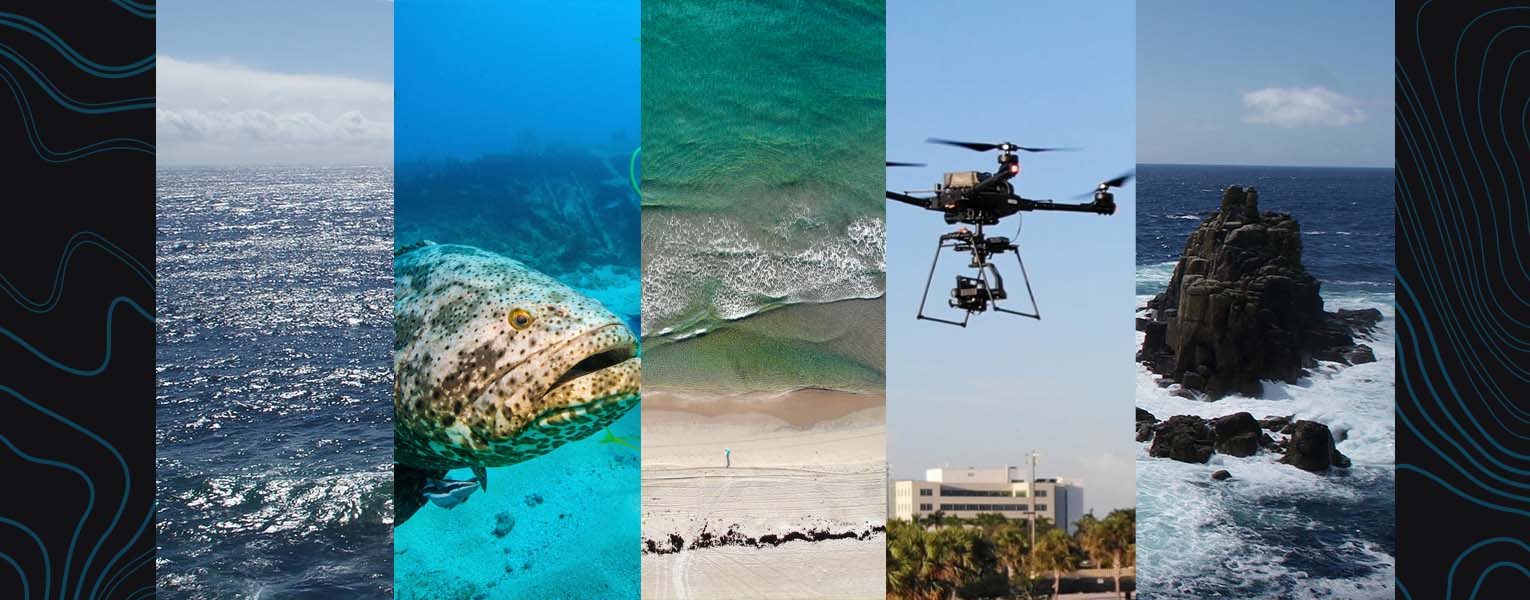Defending Our Nation by Land, Air and Sea
FAU Researchers at the Forefront of Scientific and Technological Advances
By Gisele Galoustian
The United States is increasingly under threat, from foreign and domestic terrorism to cyberattacks and the pervasive spread of misinformation. During World War II, Florida Atlantic’s 5,800-acre Boca Raton campus served as an airbase for radar training by the U.S. Army Air Corps, doing its part to help win the war. Now, it’s only fitting that researchers across the university are doing their part to help defend our nation by land, by air and by sea.
Aiming skyward, FAU scientists are using quantum physics to combat hacked bank and social media accounts, energy grids and medical records that threaten the security of the nation’s health, money, energy, society and infrastructure. By harnessing the laws of nature, they are developing a cutting-edge teleportation technology to take cybersecurity to new, “unhackable” heights using minuscule particles of light or “beams.”
In concert with Qubitekk, L3Harris and the U.S. Air Force Research Laboratory (AFRL), FAU is entrusted by the U.S. Office of the Secretary of Defense to lead America’s efforts to deliver the first drone-based, mobile quantum network to seamlessly maneuver around buildings, inclement weather and terrain, and quickly adapt to changing environments such as warfare.
The network includes a ground station, drones, lasers and fiber optics to share quantum-secured information. Today’s telecommunication networks use fiber optics, connected by laser beams from the ground and between planes and satellites — called fiber and free space optical networks. Drones are used to save lives, secure infrastructure, help the environment and thwart hostile military advances.
“The combination of quantum communication and unmanned aerial systems or UAS in this project represents an important advance in the Air Force’s efforts to create fieldable quantum systems for the warfighter,” said A. Matthew Smith, Ph.D., a senior research physicist at the AFRL Information Directorate. “Additionally, the potential of secure communication from a portable quantum communication UAS in contested environments represents important future capabilities for the Air Force.”
At the helm of this project is FAU’s Warner L. Miller, Ph.D., a professor of physics in the Charles E. Schmidt College of Science and a retired lieutenant colonel, U.S. Air Force, who served honorably for 28 years and received a Meritorious Service Medal with Oak Leaf Cluster.
“In war, for example, these drones would provide one-time crypto-keys to exchange critical information, which spies and enemies would not be able to intercept,” Miller said. “Quantum protects our information using the laws of nature and not just by a clever manmade code. One of our collaborators aptly stated, ‘whoever wins the quantum race will win the war.’”
Along these lines, FAU’s Center for Connected Autonomy and Artificial Intelligence (CCAAI) is developing a new generation of networked, cooperating robots and the nation’s first-of-its-kind testbed platform to connect them using extremely high-speed millimeter wave links.
These high-frequency radio waves (30 to 300 gigahertz), until more recently, were primarily used for remote sensing, radio astronomy, automotive radar and security screening.
Under the leadership of the CCAAI’s director, Dimitris Pados, Ph.D., Schmidt Eminent Scholar Professor in the College of Engineering and Computer Science and a fellow of FAU’s Institute for Sensing and Embedded Network Systems Engineering (I-SENSE), researchers are developing new multi-agent learning algorithms executed over the networked robots, as well as protocols for networked robotic team operation.
Because data is the fuel to train and operate AI systems, the researchers also are evaluating data quality. To train the robots, they are using curated data sets developed under a project funded by the U.S. Air Force Office of Scientific Research, which is aimed at evaluating data quality and suppressing faulty entries. They also are working to stop saboteurs’ attempts to inject faulty data to mislead autonomous systems by carrying out real-time operational data monitoring.
“Whenever you have faulty robots or a faulty autonomous system, it usually is the data that is at the root of the problem,” Pados said. “We are developing novel theory and algorithms to identify values in data that don’t conform to or make sense when they are correlated with each other, to serve as a warning system to let humans know that something is off.”
On the ground, FAU researchers are developing and enhancing body armor materials to improve the performance of military helmets and body armor. Their secret weapon? Advanced composite fibers that will potentially lead to greater energy absorption and ballistic performance, and ultimately, greater protection of the women and men who serve in the U.S. military.
Ballistic or bullet-proof armor performance is heavily dependent on the base material properties, which have changed little in recent years. The fibers in an armor absorb ballistic energy and dissipate it as quickly as possible when the projectile strikes. Fiber strength, modulus and fracture strain are key parameters for absorption and dissipation.
The project, spearheaded by College of Engineering and Computer Science professors Hassan Mahfuz, Ph.D.; Oren Masory, Ph.D.; and Leif A. Carlsson, Ph.D. was supported by a grant from the Combating Terrorism Technical Support Office, under the U.S. Department of Defense.
“Although current body armor provides increasingly advanced protection to our soldiers, it comes at a cost. It’s heavy, cumbersome, and way above the desired aerial density, which limits mobility and physical performance of our soldiers,” Mahfuz said. “We are hopeful the hybridized nanocomposite fiber we are developing will help to take body armor to the next level.”
Undersea, goliath groupers, which can reach up to 700 pounds, may be key to national security. Scientists from FAU’s Harbor Branch Oceanographic Institute have been awarded up to $5 million from the Defense Advanced Research Projects Agency (DARPA) as part of the Persistent Aquatic Living Sensors (PALS) program. This new, bio-centric PALS technology will augment the U.S. Department of Defense’s existing, hardware-based maritime monitoring systems and greatly extend the range, sensitivity and lifetime of the military’s undersea surveillance capabilities.
“Grouper Guard,” FAU’s four-year PALS project, was developed by Laurent Chérubin, Ph.D., a research professor; and Matt Ajemian, Ph.D., an assistant research professor, both at FAU Harbor Branch. Grouper Guard records and analyzes vocalization cues from goliath groupers and then sends alerts to a remote end user.
Although many species of fish produce sound, goliath groupers generate characteristic low-frequency sounds when they mate as well as when they are approached by divers, assumingly due to distress. The “boom” sounds that they make are acoustically distinct from other species of groupers.
“Our non-invasive undersea surveillance and monitoring technologies will be subtly integrated into goliath grouper habitats,” said Chérubin, principal investigator. “An acoustic response will alert authorities to the presence of a potential threat or intruder, or indeed to any object that is suspicious or ‘out of place’ within this species’ usual visual and acoustic landscape.”
From the ocean surface to the deep seafloor, bioluminescent creatures are found throughout marine habitats. This “glowing” energy released from chemical reactions emitted by these organisms is used to warn or evade predators, lure or detect prey and communicate with members of the same species.
Research surrounding bioluminescence will soon serve as an important tool to protect U.S. coastlines. In 2020, FAU Harbor Branch’s Michael Twardowski, Ph.D., principal investigator and a research professor, received an $11,179,001 four-year contract from the U.S. Office of Naval Research (ONR) to develop a next-generation, high-intake, compact, defined excitation bathyphotometer sensor for natural oceanic bioluminescence assessments.
The contract involves imaging, modeling and significant fieldwork to better understand bioluminescence dynamics in the ocean. Nearly all coastal and open ocean regions, particularly waters with high productivity, have conditions favorable for bioluminescence emission at night.
Bioluminescence can be detected remotely, above water, with the naked eye or with camera systems. No current bioluminescence measurement system has the ability to measure the full light emission potential of the organisms in the water column. Existing bathyphotometers with low flow rates are typically relevant only for passive phytoplankton, usually found near the water’s surface. The project, “Next Generation Sensor Systems for Natural Oceanic Bioluminescence Assessments,” was competitively procured under the “Long Range Broad Agency Announcement (BAA) for Navy and Marine Corps Science and Technology,” under the purview of the ONR.
“Working with the U.S. Office of Naval Research and our academic and corporate partners, we are not only developing a next generation ‘gold standard’ sensor that will be compact and versatile in deployment, but continuing a legacy of research in oceanic bioluminescence and its role in ocean ecology,” Twardowski said.
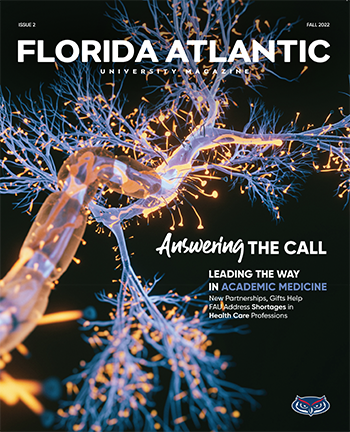
This story comes from the Florida Atlantic magazine. View stories like this and more at www.fau.edu/newsdesk/magazine.
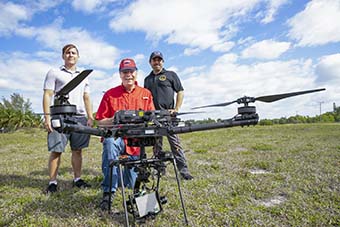
FAU graduate student Anthony Davis; Warner A. Miller, Ph.D.; and collaborator Pedram Nimreezi, stand behind the large drone, which includes a network of a ground station, lasers and fiber optics.
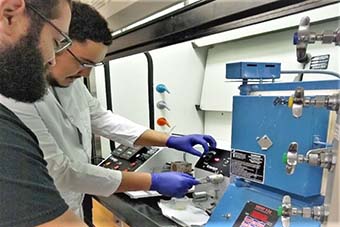
Reinaldo Dos Santos, left, and Vitor Prado Correia, graduates of FAU’s Department of Ocean and Mechanical Engineering, extruding fiber in the laboratory under the direction of Hassan Mahfuz, Ph.D., principal investigator, and Oren Masory, Ph.D., co-principal investigator of the body armor project.
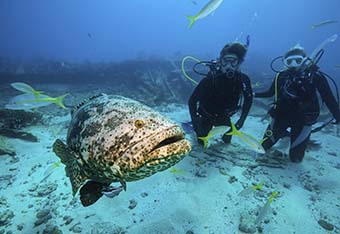
While many species of fish produce sound, the goliath grouper, which can reach up to 700 pounds, generates characteristic low-frequency sounds when they mate as well as when they are approached by divers. The “boom” sounds that they make are acoustically distinct from other species of groupers.
If you would like more information, please contact us at dorcommunications@fau.edu.
